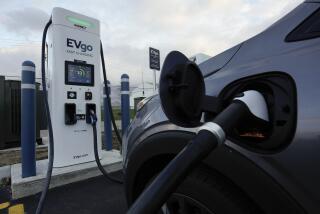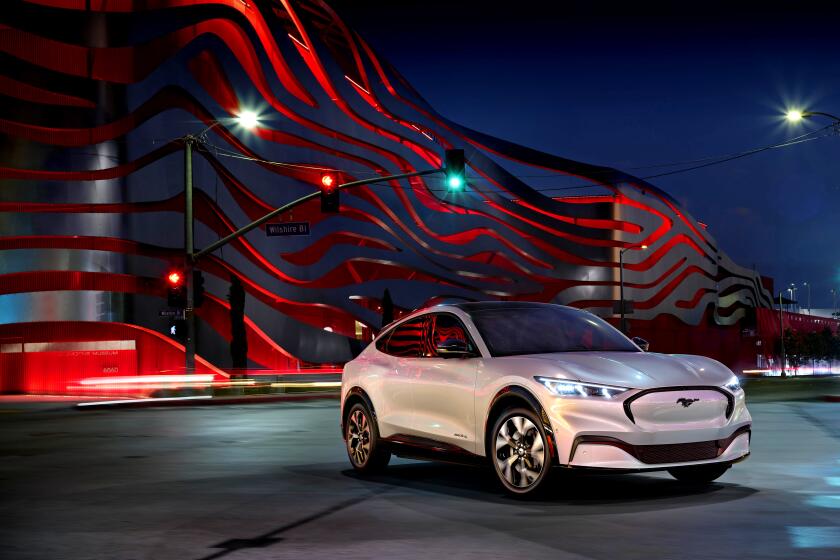BMW 535d leads the pack among diesel luxury sedans
The best place to find a diesel these days isn’t a freeway truck stop. It’s the country club.
Brands like BMW, Mercedes-Benz and Audi have always sold diesel cars on their home turf back in Germany. Mercedes in particular had success selling oil-burning diesels to Americans in the 1970s and ‘80s, before emissions regulations tightened.
Thirty years later, diesels are clawing their way back into the U.S., largely because of the fuel economy they deliver, better emissions controls and cleaner diesel fuel. Indeed, diesels are now considered competitors with hybrids in the green car space.
They’re also quite a bit more fun to drive.
With an easier path for existing diesels to emigrate, the luxury world is awash with new models that were previously off-limits to U.S. drivers. The number of high-end diesel vehicles has doubled in the last five years, and mid-size sedans are at the heart of that growth, according to data from Edmunds.com.
So we grabbed three sedans from brands on the front lines of diesel production. The BMW 535d and the Mercedes-Benz E250 BlueTec are new models for 2014, whereas the Audi A6 TDI has been around for a few years. Here’s how the comparison played out:
First place: BMW 535d
BMW gave the current generation of 5-Series cars a mild refresh for 2014, adding this diesel into the mix for the first time. It combines efficiency with robust power in a package so compelling that there’s no reason to buy the gas-powered 535i.
The best part of this BMW is the engine, one it shares with the X5 SUV and a 7-Series sedan. A turbocharged, 3.0-liter inline six-cylinder engine pumps out 255 horsepower and 413 pound-feet of torque. It’s bolted to an eight-speed automatic transmission that routs the power to the car’s rear wheels.
Everything about this drivetrain is silky smooth. There’s no rough idle or vibration during acceleration, and the car has more than enough power to validate BMW’s performance credentials.
Although its 5.8-second run from zero to 60 mph is 0.3 second slower than that of the Audi, it’s a more engaging experience and feels faster than those numbers suggest.
The Environmental Protection Agency rates the BMW 535d’s efficiency at 26 miles per gallon in city driving and 38 mpg on the highway, making the car 25% less thirsty than its gas-powered twin. After 350 miles of testing, in more city driving than highway, we averaged 28 mpg.
Inside, the 535d wins on refinement. The 2014 refresh tweaked an already plush interior, and this cabin was easily the classiest and most comfortable of the three sedans tested. Highlights included a massive panoramic moon roof, a 10.2-inch navigation screen and updated iDrive controller with a new touch pad built into it.
The 535d starts at $57,525, but our tester piled on an additional $8,900 worth of relatively mundane options. But for all that coin, the car still doesn’t have a backup camera or parking sensors, which is silly considering they seem to be standard on everything but tricycles now.
But even with the stress of parking by feel, this is the diesel sedan we’d choose. It’s exactly the kind of ambassador that diesel cars need to show how power and efficiency can live together happily.
Second-place tie: Audi A6 TDI and Mercedes-Benz E250 BlueTec
After the BMW runs away with the mid-size diesel crown, it leaves Audi and Mercedes fighting for second place. That battle will depend on individual buyers’ tastes.
The Audi is quieter, more refined and more powerful than the Mercedes. Consider it a BMW-lite: It does everything well, just not as well as the 535d.
Meanwhile, Mercedes aimed for value and efficiency with the E250. Although it scores big on each, it loses some sophistication in the process.
Like BMW, Mercedes refreshed this generation of its mid-size car for 2014. E-Class models got the kind of face-lift that replaces the relentless severity of the previous version with a fresh dose of style.
Although its peers still use more powerful six-cylinder engines, Mercedes chose to fight a war on price rather than power. It replaced the older six-cylinder diesel with the smaller four-cylinder.
The new turbocharged 2.1-liter, four-cylinder engine has 195 horsepower and 369 pound-feet of torque, which moves the E250 from zero to 60 mph in 7.9 seconds. A seven-speed automatic transmission directs this power to the rear wheels, though all-wheel drive is an option.
We averaged 35 mpg in our week with the car. That’s the best of this trio, though that figure included more time on the highway than was spent with the BMW or the Audi. The EPA rates the Mercedes at 28 mpg in the city and 42 mpg on the highway.
The E250 is now the cheapest model in the E-Class lineup, starting at $52,325. That’s a cool $5,000 cheaper than the BMW’s base price, though after options are piled on to each car, the gap narrows to $3,000.
The E250 is aimed at buyers who drive with their pocketbooks and their brains rather than their right foot. To that extent, it’s a compelling choice.
But the Mercedes makes a few crucial sacrifices that won’t sit well with all luxury buyers. The car is slower than its peers, the engine is louder and less refined, and the cabin isn’t as plush as that of the Audi or BMW.
That’s not to say the E250 drives like a neglected semi truck. It’s a Mercedes after all, and it lives up to its maker’s expectations. Just don’t buy it thinking it will handle like a sports sedan.
Inside, the Benz is more austere than the others; the design and execution are more reserved than plush. And a navigation system isn’t standard like it is on the Audi and BMW. Consider that a good thing. Not only will it save you money, but a chimpanzee with a road map would be better at giving directions than the system in our test car.
This leaves the Audi A6 TDI. Although it does nothing wrong, it just can’t beat the BMW at its own game.
Unlike the other cars we tested, the Audi comes only in all-wheel drive. Although this hurts it a smidge on fuel economy for our comparison, the A6 is still less efficient than AWD versions of the BMW and Mercedes.
The upshot for the Audi is all that grip during acceleration makes it the fastest sprinter of the group, with a 5.5-second zero-to-60-mph time, according to the automaker.
Moving the car is a turbocharged 3.0-liter six-cylinder engine that makes 240 horsepower and 428 pound-feet of torque. It’s hooked up to an eight-speed automatic transmission. The EPA rates this combination at 24 mpg in city driving and 38 on the highway. We averaged 29 mpg in more city driving, about the same as the BMW but well behind the Mercedes.
The A6 is plenty smooth and quiet, though its personality is more subdued than the BMW’s.
The Audi’s $58,395 base price and $66,795 as-tested price were the highest of the group, but you get what you pay for.
The base price includes the aforementioned Quattro AWD system, navigation, the driver-selectable modes, a moon roof and three-zone climate control. Our Prestige model added things like adaptive cruise control, pre-collision braking, lane-keeping assist, a 360-degree camera and ventilated seats.
The Audi has no glaring faults. It just falls short of what BMW delivers and it has a different ethos than the Mercedes.
david.undercoffler@latimes.com







